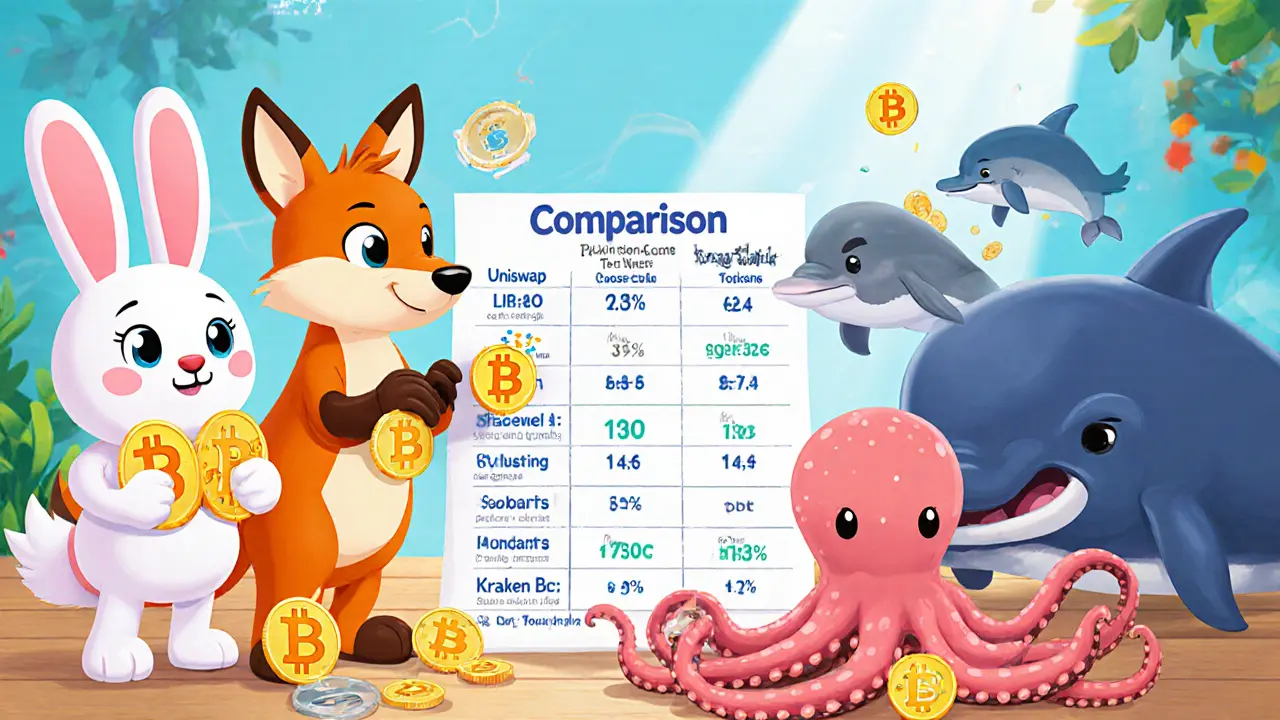Libre Swap Feature Comparison Tool
This tool compares Libre Swap with major decentralized exchanges (DEXs) to help you understand its position in the DeFi landscape.
Feature Comparison Table
| Platform | Supported Blockchains | Token Count | Cross-Chain Swaps | Typical Fee | 24h Volume (USD) |
|---|---|---|---|---|---|
| Libre Swap | Libre | ~2 (BTC, LIBRE) | No | Undisclosed | ~$54k (BTC/LIBRE) |
| Uniswap | Ethereum | Thousands (ERC-20) | No (single-chain) | 0.30% | $1.2B |
| 1inch | Multi-chain (Ethereum, BNB, Polygon…) | Thousands | Yes (router) | 0.10-0.30% | $850M |
| Symbiosis Finance | Multi-chain | Hundreds | Yes (native cross-chain) | 0.05-0.20% | $320M |
| Kraken (centralized) | Multiple (BTC, ETH, ALT, fiat) | 450+ | Yes (fiat on-ramp) | 0.20-2.95% | $2.6B |
Key Insights
- Libre Swap is limited to the Libre blockchain with only 2 token pairs.
- It lacks cross-chain functionality, unlike 1inch and Symbiosis Finance.
- Its fee structure is not disclosed, unlike established DEXs like Uniswap.
- Trading volume is significantly lower compared to top-tier DEXs.
- It's best suited for early adopters within the Libre ecosystem.
Libre Swap review - what you need to know before you trade on this fresh DeFi platform.
Quick Take
- Libre Swap is a permissionless DEX built on the Libre blockchain and launched in 2023.
- It currently supports a single native pair (BTC/LIBRE) with very low reported volume.
- Fees and security audits are not publicly disclosed, creating a transparency gap.
- Compared with established DEXs, Libre Swap offers limited token support and no cross‑chain routing.
- Ideal only for early adopters who already hold Libre tokens and want to experiment within the Libre ecosystem.
What Is Libre Swap?
Libre Swap is an open‑source, decentralized, permissionless swap protocol that runs on the Libre blockchain. It allows anyone with a Libre account to add liquidity and trade without a traditional KYC process. The platform was incorporated in Panama in 2023 and is maintained by a distributed team of developers from Costa Rica, Argentina, and the broader Libre Tech organization.
Core Technical Specs
The exchange runs as a smart‑contract suite on the Libre blockchain. Unlike multi‑chain DEXs such as Uniswap (Ethereum) or 1inch (cross‑chain), Libre Swap is confined to the Libre ecosystem. The primary trading pair listed is BTC/LIBRE, with Bitcoin priced around $117,800 at the time of writing. Some data aggregators claim additional pairs like pBTC/pUSDT, but the platform’s UI only displays the BTC/LIBRE swap.
Liquidity and Trading Volume
Tracking platforms disagree on the exact numbers. CoinGecko reports a 24‑hour volume of $0.00 for the exchange overall, yet it shows about $54,000 for the BTC/LIBRE pair. CoinMarketCap lists Libre Swap as an "Untracked Listing" with no volume data. This inconsistency suggests that real‑world liquidity is either extremely thin or that the platform is still in a testing phase. When liquidity is low, slippage can become severe, making even modest trades costly.
Fees and Cost Structure
Libre Swap does not publish a fee schedule. Most DEXs charge a protocol fee (often 0.3%) plus a gas cost that depends on the underlying blockchain. Libre’s native blockchain has relatively low transaction fees, but without an official statement users cannot be sure whether a protocol fee is applied or how it is split between liquidity providers and the platform. This opacity is a red flag for anyone budgeting trade costs.
Security Considerations
Security information is scarce. The platform’s open‑source code is publicly available, yet there is no record of an independent smart‑contract audit, multi‑signature wallet integration, or bug‑bounty program. In the DeFi space, audited contracts are a baseline for trust. While decentralization reduces custodial risk, unchecked contracts expose users to potential exploits. Until Libre Swap publishes audit results, users should treat the platform as experimental.

How Libre Swap Stacks Up Against Other DEXs
Below is a snapshot comparison that highlights where Libre Swap falls short and where it offers unique value.
| Platform | Supported Blockchains | Token Count | Cross‑Chain Swaps | Typical Fee | 24h Volume (USD) |
|---|---|---|---|---|---|
| Libre Swap | Libre | ~2 (BTC, LIBRE) | No | Undisclosed | ~$54k (BTC/LIBRE) |
| Uniswap | Ethereum | Thousands (ERC‑20) | No (single‑chain) | 0.30% | $1.2B |
| 1inch | Multi‑chain (Ethereum, BNB, Polygon…) | Thousands | Yes (router) | 0.10‑0.30% | $850M |
| Symbiosis Finance | Multi‑chain | Hundreds | Yes (native cross‑chain) | 0.05‑0.20% | $320M |
| Kraken (centralized) | Multiple (BTC, ETH, ALT, fiat) | 450+ | Yes (fiat on‑ramp) | 0.20‑2.95% | $2.6B |
Pros and Cons Checklist
- Pros
- Permissionless access - no KYC required.
- Low on‑chain transaction fees thanks to the Libre network.
- Open‑source code can be audited independently.
- Cons
- Only one actively listed trading pair; token selection is extremely limited.
- No public fee schedule or audit reports - transparency gap.
- Thin liquidity leads to high slippage for larger trades.
- Lacks cross‑chain swapping, which is now standard in 2025.
Who Should Consider Using Libre Swap?
If you already hold LIBRE tokens and want to experiment with swapping within the same blockchain, Libre Swap offers a straightforward, KYC‑free experience. Early‑stage developers or community members looking to provide liquidity can also benefit from the platform’s permissionless nature. For traders who need deep liquidity, multiple token pairs, or proven security audits, established DEXs or centralized exchanges remain the safer bet.
Regulatory and Legal Outlook
Incorporated in Panama, Libre Swap enjoys a relatively relaxed regulatory environment. However, the platform’s permissionless model can trigger local crypto bans in jurisdictions with strict anti‑money‑laundering rules. Users should verify whether their country permits trading on unregistered decentralized services before committing funds.
Future Roadmap - What’s Next?
The development team has not published a concrete roadmap, but community speculation points to three likely upgrades:
- Adding more Libre‑native tokens and expanding the pair list beyond BTC/LIBRE.
- Publishing a formal security audit and fee schedule to boost credibility.
- Implementing a cross‑chain bridge to connect Libre with major networks like Ethereum and BNB.
These steps would bring Libre Swap closer to the feature set offered by rivals such as Uniswap and 1inch, but until they materialize the platform remains a niche experiment.
Bottom Line
Libre Swap is a bold attempt to create a native DEX for the Libre blockchain, but its limited token support, opaque fee model, and missing security audits keep it firmly in the early‑adopter camp. If you’re curious about the Libre ecosystem and comfortable with experimental platforms, a small test trade could be worthwhile. Otherwise, more mature decentralized or centralized exchanges will likely give you better liquidity, clearer costs, and stronger safety guarantees.
Frequently Asked Questions
Is Libre Swap safe to use?
Safety is hard to gauge because Libre Swap has not published any independent smart‑contract audits. The platform’s open‑source code can be reviewed, but without a formal audit you should treat it as experimental and only trade amounts you can afford to lose.
What tokens can I trade on Libre Swap?
At the moment the only actively listed pair is BTC/LIBRE. Some data sources mention additional pairs such as pBTC/pUSDT, but they are not displayed in the platform’s UI.
How do fees work on Libre Swap?
Libre Swap has not disclosed a fee schedule. Users should assume a protocol fee similar to other DEXs (around 0.3%) in addition to the low transaction cost of the Libre blockchain.
Can I use Libre Swap from any country?
Because the platform is permissionless and incorporated in Panama, there is no built‑in KYC. However, local regulations may still prohibit access to unregistered DeFi services, so check your jurisdiction’s crypto rules first.
What’s the future outlook for Libre Swap?
The team has hinted at adding more Libre‑native tokens, publishing a fee model, and possibly building a cross‑chain bridge. Until those updates arrive, the exchange will stay a niche player serving early adopters of the Libre blockchain.







Write a comment